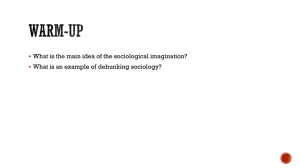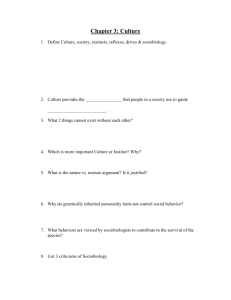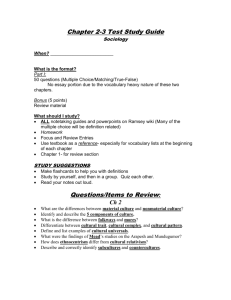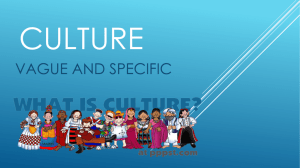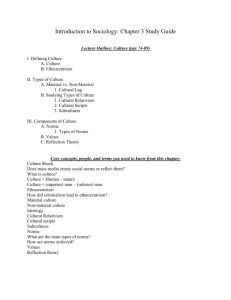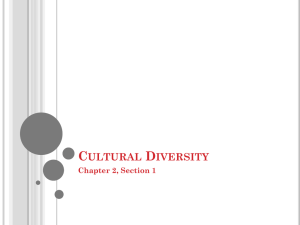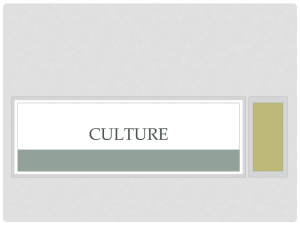Textbook questions for chapter 3
advertisement
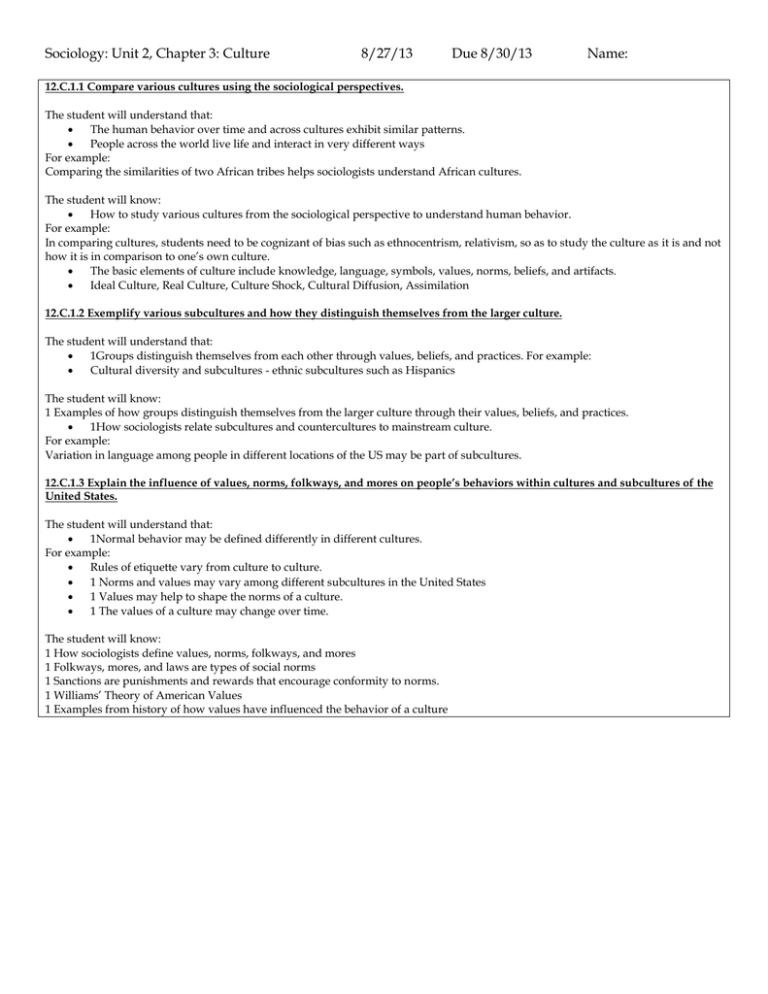
Sociology: Unit 2, Chapter 3: Culture 8/27/13 Due 8/30/13 Name: 12.C.1.1 Compare various cultures using the sociological perspectives. The student will understand that: The human behavior over time and across cultures exhibit similar patterns. People across the world live life and interact in very different ways For example: Comparing the similarities of two African tribes helps sociologists understand African cultures. The student will know: How to study various cultures from the sociological perspective to understand human behavior. For example: In comparing cultures, students need to be cognizant of bias such as ethnocentrism, relativism, so as to study the culture as it is and not how it is in comparison to one’s own culture. The basic elements of culture include knowledge, language, symbols, values, norms, beliefs, and artifacts. Ideal Culture, Real Culture, Culture Shock, Cultural Diffusion, Assimilation 12.C.1.2 Exemplify various subcultures and how they distinguish themselves from the larger culture. The student will understand that: 1Groups distinguish themselves from each other through values, beliefs, and practices. For example: Cultural diversity and subcultures - ethnic subcultures such as Hispanics The student will know: 1 Examples of how groups distinguish themselves from the larger culture through their values, beliefs, and practices. 1How sociologists relate subcultures and countercultures to mainstream culture. For example: Variation in language among people in different locations of the US may be part of subcultures. 12.C.1.3 Explain the influence of values, norms, folkways, and mores on people’s behaviors within cultures and subcultures of the United States. The student will understand that: 1Normal behavior may be defined differently in different cultures. For example: Rules of etiquette vary from culture to culture. 1 Norms and values may vary among different subcultures in the United States 1 Values may help to shape the norms of a culture. 1 The values of a culture may change over time. The student will know: 1 How sociologists define values, norms, folkways, and mores 1 Folkways, mores, and laws are types of social norms 1 Sanctions are punishments and rewards that encourage conformity to norms. 1 Williams’ Theory of American Values 1 Examples from history of how values have influenced the behavior of a culture Section 1, pp. 72-73 1. How is culture different from society? (Do not just define the two – how are they different? 2. What does the example of mothering tells us about instincts? (p. 73) 3. (p. 73) “You should realize, however, that genetically inherited personality traits, reflexes and drives do not control human behavior.” Explain this statement, using the examples in the text following this sentence. Section 2, pp. 77- 80 4. How is a wedding ring a symbol in our culture? (What cultural information does it give us?) 5. Read the sections on 77-79 and explain this statement: “language shapes the way we think.” (This is also known as the Sapir-Whorf hypothesis.) 6. THINK: how do recent innovations like “smiley” icons , texting and Twitter (with 140 character limits) change they way we use language – and therefore think? 7. Explain the point of the story on p. 80. (The definition of cultural relativism is “ the principle that an individual human's beliefs and activities should be understood by others in terms of that individual's own culture.”) Section 3, p. 81-91 8. Explain one norm that you have come to expect in a high school classroom. Term Folkways Mores Definition Give an example of this that has to do with high schools/US education. Laws 9. For this question, complete the box above. 10. Explain what sanctions are in general, and how/when formal and informal sanctions are used. 11. Go back to the bottom of p. 85, where smoking is discussed. Explain what a) formal and b) informal sanctions are in place today in the US if someone is smoking in public. 12. Explain what values are. THINK: are values more cognitive (based on logical thinking) or emotional (based on gut feelings)? Explain your answer. 13. PLEASE either redraw or explain the Values Kite on p. 89. (It really helps!) Section 4, p. 92-94 14. Are beliefs more cognitive or emotional? Explain your answer. 15. Think of a sport or hobby that you know well. What is the material culture and nonmaterial culture used in that sport or hobby? (If you are stuck, think of basketball – what are the tangible objects needed to play, and what are the skills, attitudes and values needed to succeed?) 16. Explain how ideal culture and real culture are different, using the speed limit in your example. Section 5, pp. 9517. How do subcultures and countercultures differ from the dominant culture? How can you explain the difference between them? 18. Why is ethnocentrism (starts at bottom of p. 98) such an important concept when learning about culture? 19. How are cultural universals differ from cultural particulars? 20. THINK: how does the Internet and media (like TV and movies) affect cultural particulars?
